

comment:
White or Carpenter's Glue has too much water in it and it can deform the paper.
Mucilage dries slowly and often is too easily absorbed into the paper hence weakening its bonding qualities.
White Paste is easy to apply excessively and is slow to dry.
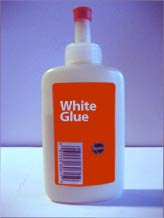
comments : While not always essential in workshops using cardboard and coverstock, this glue remains a useful item to have on hand - just in case!
Certain brands of school-grade white glue are not effective when secure gluing is a priority. Where adhesive qualities are essential, better to purchase a recognized brand. If in doubt make inquiries at your local hardware or business supply store.

You will find bushes useful in Paint Storming and the Cardboard Sculpture Workshops but they are not essential.
1-inch wide, square- tipped brushes are common in schools but wider brushes would be fine. The best would be a variety of widths.
The object is to encourage participants to work at a scale larger than normal.
Cartooning and Comic Strip sizes: #4 - #12.
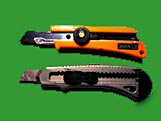
comment: If these tools cannot be used in classroom then thinner cardboard or bristol is a must.

comment
These are special surfaces that resist knive cuts. They literally reseal after
having been sliced by a knive blade.
Why use cutting boards? Isn't cardboard just as good? Not really, the more you cut cardboard the more it weakens and the more likely the blade will pierce it and cut into the desktop.
Knive blade cuts ruin table tops.
Cutting directly on desktops dulls blades. Blades that have lost their edge are actually more danerous than sharp ones. To cut with a dull blade you usually apply more pressure, and more force means that it is easy to loose control.
If these tools are to be used in a workshop, the artist always gives a short talk on the proper use of knives and their care.
The best are the white plastic erasers. They do not damage the surface rubbed and are very good at removing unwanted marks.
The pink variety are less efficient and can damage paper surfaces.
comment: This ink is widely available in bottles of various sizes at art and business supply stores.
You will need a minimum of 2 small containers for each participant: 1 for the ink and 1 for water to clean brushes. Baby food jars with lids are ideal. Small yoghurt containers are acceptable but they lack lids!

comment: in the Cartooning and Comic Strip / Book Workshops, fine-pointed markers are used in addition to the heavy, wide, wedge-tipped ones.
Generally all preliminary marker drawing is done in black, permanent marker.
Should you be wary of odours when using permanent markers, water soluble are fine. But remember that water-based markers prevent the use of water-paints as they will run. They are also less than permanent and will fade if subjected to daylight for long periods of time.

comment: Make sure the pads are not newsprint. The paper should be a bright white not a gray or beige colour.

comment : Not for use in the Paper Sculpture Workshop. While not essential in the Cardboard Sculpture 1, 2 and 3 Workshops, water-based paint is highly recommended for adding colour to such projects.

comment : Generally student-grade oil paint is fine but not always within the budget of these workshops. House paint frequently lacks a practical colour selection as we are often dealing with recyclables thanks to helpful teachers and parents. Where cost is always a consideration water-based paints are usually best.
Pointers to help you get the right boxes for these projects:
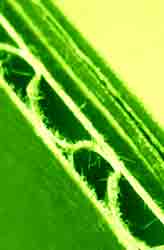
comment:
Always look for boxes for computer / photocopier paper, electric light bulbs, disposable tissues, cereal or other light items.
Do not take cartons for fruit, dishes, glassware or heavy items as they are often muli-layered (2-ply or more) and much too difficult to cut.
comment : Selection and quantities will vary from school to school. Paul will make every effort to use school supplies wherever possible.
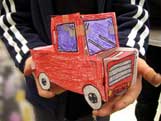
comment : As opposed to regular paper, cardstock has the stiffness that makes the construction of the car, pictured above, possible.
We add colour with markers, coloured pencils, pastels, etc.
comment : Selection and quantities will vary from school to school. Paul will make every effort to use school supplies wherever possible.
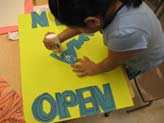
Sometimes gluing a poster made with construction paper and markers takes a firm grip and a little muscle
Photo : Paul Walty © 2007
comment : Paper Sculpture Workshop
Some lots of this paper are extremely flimsy. In this case, it would be wiser
to buy cardstock.
comment: Probably the best paper for painting, in terms of affordability and durability, commonly found in schools.
comment : Selection and quantities will vary from school to school. Paul will make every effort to use school supplies wherever possible.
comment : This paper is acceptable for preliminary planning exercises, storyboarding, etc. but not recommended should the work be something worth displaying in the school.
comment :
Cartooning Workshop: the letter-size format.
Comic Strip / Book Workshop
the formats of choice :
Publication formats
letter or legal (8 1/2 X 14 inches; 21.59 X 35.56 cm). Here we are talking about a project that includes the creation
of a book containing samples of all participants work.
If your pencils are HB, you need read no further! between your fingers. You will probably see one of, some of, or all of the following:
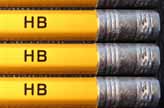
HB?
Look along the pencil shaft. The letter(s) you find indicate the hardness of the pencil lead.
An HB indicates a medium hardness. Most school pencils are HB. A B lead is softer than an HB and an H is harder.
The HB, or medium hardness pencil, is the drawing instrument for all workshops requiring pencils.

comment: Most light-weight papers like construction, cartridge, manila and even a light bristol can be cut with scissors without too much difficulty. If your scissors are not up to the job, then particpants will have difficulty as all these workshops depend on good scissors that cut.
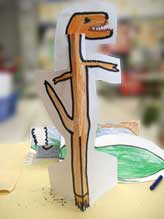
Hard to believe that all it takes to get this dinosaur up and taking a bow is a sheet or two of white cardstock and a couple of coloured markers.
Crecent Town Elementary School, Toronto, Ontario.
PHOTO: PAUL WALTY · 2006